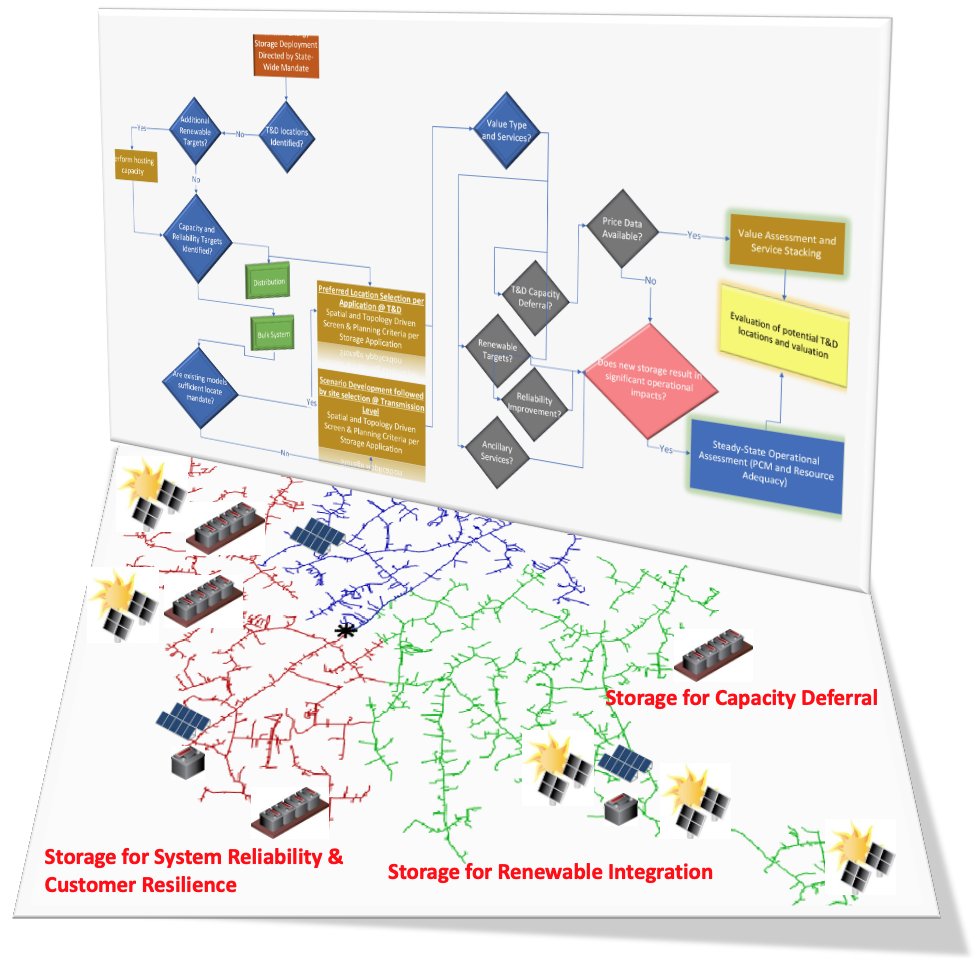Difference between revisions of "Energy Storage Analysis Case Studies"
| Line 7: | Line 7: | ||
For a more detailed discussion of energy storage modeling, valuation, and available tools, see the [[Energy_Storage_Valuation | Energy Storage Valuation]] page. | For a more detailed discussion of energy storage modeling, valuation, and available tools, see the [[Energy_Storage_Valuation | Energy Storage Valuation]] page. | ||
The analysis case studies are divided | The analysis case studies are divided into categories below. | ||
{| class="wikitable" | {| class="wikitable" | ||
! Description | ! Description | ||
! | ! Category | ||
|- | |||
|[[/2019_Case_Studies/Transmission_Deferral | Energy Storage to Offset Need for New Transmission]] | |||
|Transmission | |||
|- | |||
|[[/2019_Case_Studies/System_Service_Stacking | Stacking Reliability with System-Level Services from Energy Storage]] | |||
|Customer | |||
|- | |||
|[[/2019_Case_Studies/Deferral_Screening | Distribution Upgrade Deferral with Energy Storage Screening Analysis]] | |||
|Distribution | |||
|- | |||
|[[/2019_Case_Studies/High_Renewable_Feasibility | Feasibility of Large Storage with High Renewable Penetration]] | |||
|Wholesale | |||
|- | |||
|[[/2020_Case_Studies/Customer_Reliability_Sensitivity | Customer Reliability (Backup) from Economically-Optimal Storage]] | |||
|Customer | |||
|- | |||
|[[/2020_Case_Studies/Solar_Plus_Storage_Market | Large-Scale Solar PV Plus Storage Siting Analysis and Market Participation]] | |||
|Wholesale | |||
|- | |||
|[[/2020_Case_Studies/Hosting_Capacity | Increase PV Hosting Capacity with Energy Storage]] | |||
|Distribution | |||
|- | |||
|[[/2020_Case_Studies/Distribution_Reliability | Distribution Reliability Improvement (Backup) from Energy Storage]] | |||
|Distribution | |||
|- | |||
|[[/2020_Case_Studies/Distribution_Capacity_DSM_ESS | Distribution Capacity from Energy Storage and Demand Side Management]] | |||
|Distribution | |||
|- | |||
|[[/2020_Case_Studies/Distribution_Capacity | Distribution Capacity from Energy Storage]] | |||
|Distribution | |||
|- | |||
|[[/2021_Case_Studies/Decarbonizing_Resilience | Decarbonizing Resilience]] | |||
|Reliability and Resilience | |||
|- | |||
|[[/2021_Case_Studies/Military_Installations | Military Installation Microgrids]] | |||
|Reliability and Resilience | |||
|- | |- | ||
|[[ | |[[/2021_Case_Studies/CHP | Combined Heat and Power]] | ||
| | |Customer | ||
|- | |- | ||
|[[ | |[[/2021_Case_Studies/GHG_Optimization | Emissions in Dispatch Optimization]] | ||
| | |Wholesale | ||
|- | |- | ||
|[[ | |[[/2021_Case_Studies/Hydrogen_Valuation | Valuation of Hydrogen Technology on the Electric Grid Using Production Cost Modeling]] | ||
| | |Wholesale | ||
|- | |- | ||
|[[ | |[[/2021_Case_Studies/ConEd_Value_Streams | Value Streams in ConEd Territory]] | ||
|Wholesale | |||
|- | |- | ||
|[[ | |[[/2022_Case_Studies/Eskom | Eskom Battery Energy Storage System Assessment Case Study]] | ||
|Distribution | |||
|} | |} | ||
'''PRIMARY AUDIENCE:''' Utilities who are exploring use cases for energy storage systems | '''PRIMARY AUDIENCE:''' Utilities who are exploring use cases for energy storage systems | ||
Revision as of 17:21, 4 March 2024
This section of the wiki contains a collection of energy storage valuation and feasibility studies that represent some of the most relevant applications for storage on an ongoing basis. Each of the analyses in this report is based on a real case study performed by EPRI. These analyses pair the Storage Value Estimation Tool(StorageVET®) or the Distributed Energy Resources Value Estimation Tool (DER-VET™) with other grid simulation tools and analysis techniques to establish the optimal size, best use of, expected value of, or technical requirements for energy storage in a range of use cases, including distribution deferral, transmission deferral, renewables integration, market participation, and microgrid applications.
For a more detailed discussion of energy storage modeling, valuation, and available tools, see the Energy Storage Valuation page.
The analysis case studies are divided into categories below.
PRIMARY AUDIENCE: Utilities who are exploring use cases for energy storage systems
KEY RESEARCH QUESTION: What are the high-value applications and associated limitations for energy storage systems on an ongoing basis as demonstrated by contemporary, relevant case studies?
RESEARCH OVERVIEW: The Storage Value Estimation Tool (StorageVET®) or the Distributed Energy Resources Value Estimation Tool (DER-VET™) was used with other grid simulation tools and analysis techniques to establish the optimal size, best use of, expected value of, or technical requirements for energy storage in a range of use cases, including distribution deferral, transmission deferral, renewables integration, market participation, and microgrid applications.was used along with transmission and distribution simulation tools and complex analysis methodologies to uncover the value and technical feasibility of energy storage systems in transmission and distribution investment deferral, market participation, and renewables integration use cases.
KEY FINDINGS:
- There are real examples where the flexibility offered by storage systems can provide an enormous amount of value relative to their cost, but careful identification, planning, and operation are required.
- When implementing very high penetrations of renewable energy, energy storage can offer a cost-effective and clean method for reconciling intermittent generation and load while maintain grid stability.
- Reconciling the differences in lifetime between storage systems and other grid assets through an approach like economic carrying cost is critical for establishing a level comparison.
WHY THIS MATTERS: Storage systems benefit from a clear definition of a primary service that is highly valuable, around which flexible, lower-value services can be stacked.
HOW TO APPLY RESULTS: The analyses in this report serve as excellent examples of technical feasibility and valuation studies for energy storage implementation EPRI software such as StorageVET and OpenDSS. They should be treated as model studies that can be replicated by the user for their own purposes. Additionally, they are a clear cross-section of highly relevant, contemporary use cases for energy storage systems that exemplify how valuable the flexibility they offer can be.
LEARNING AND ENGAGEMENT OPPORTUNITIES:
- DER-VET User Group (2021)
- Energy Storage Integration Council
EPRI CONTACTS: Miles Evans, Engineer/Scientist, mevans@epri.com
PROGRAM: Energy Storage and Distributed Generation (P94)
